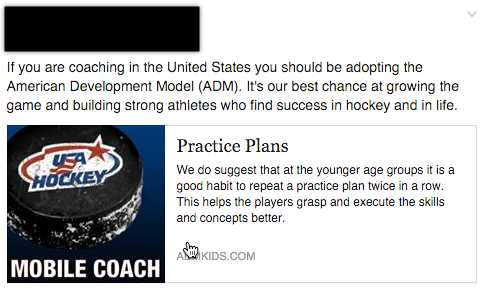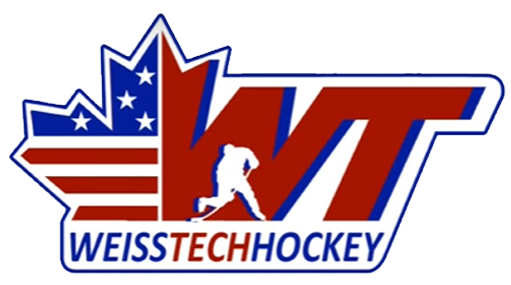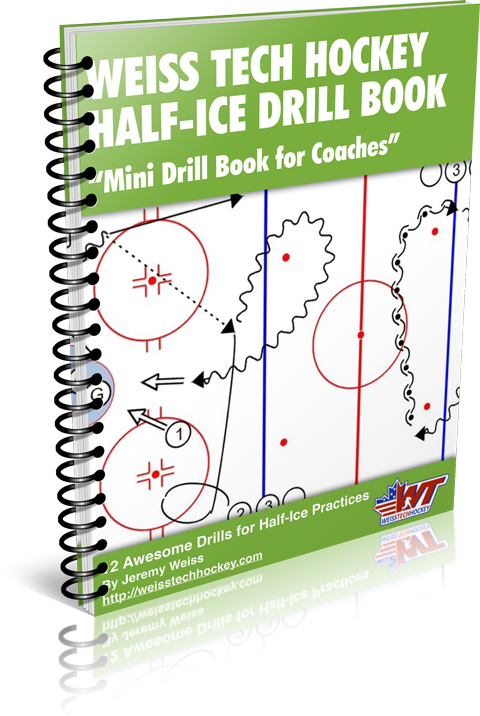Do Systems Rob from Skill Development?
Sample Article from Hockey Development Magazine – Click Here to Download the App
I was watching a conversation take place in my Facebook feed a few weeks ago. The topic centered around whether Mites should be taught “systems hockey.”
It all started with a coach who posted that every coach in the USA needs to get on board with the ADM:

So people began going back and forth on this a bit, some coaches expressing their opinions more politely than others. Then one coach said something to the effect that ADM is garbage, and that the kids don’t learn systems under ADM.
His comment garnered a reply from this coach:

Notice he says “positioning is a garbage concept” and that “skills dominate today’s game.” These two coaches went back and forth a bit more, until the first made the statement that ADM would eventually “kill USA Hockey.” To which the second coach replied as follows:

“Get on board or get passed by…”
Then a few other coaches threw in their 2 cents worth:


“Systems inhibit development of decision making and hockey sense…?!”
At this point, I figured it was time to address the topic, and show the results of my approach in action. So, I put together the video above.
The Stakes are High
The reason I feel so strongly about this topic is that the stakes are extremely high. If we get this right, our kids will be miles ahead of their peers. Get it wrong and it’s a big setback.
I believe that if we structure our development properly, Systems vs Skill Development doesn’t have to be an “either/or” proposition. In fact, it’s quite the opposite: skills can be developed BETTER when you’re teaching systems too; and systems can be progressed FASTER with better skill development.
What Takes More Skill, Dump & Chase or Systems Hockey?
Next time you have a chance, go down to the rink and watch a Mite game. My guess is that you’ll see a bunch of kids, slapping the puck around and chasing it. If they’re going cross-ice 4 on 4 (like ADM recommends), wherever the puck goes, you’ll see 8 kids clustered around it, battling like piranhas in a feeding frenzy. Eventually the fastest kid will come up with the puck, take it all the way down the ice, and score.
So here’s the question: Does it take more individual skill to slap the puck and chase it, or to set up a breakout, carry the puck behind the net, find a teammate on the boards, make a stick to stick pass, carry the puck wide, then pass to the middle for a goal?
Obviously, the controlled game takes more skill. It also takes more effort as a coach. But it is so much more beneficial to your players!
Conclusion
As you’ll see in the video above, I teach basic positioning to my Mite house team, and it works beautifully. Not only are they the team with the best positioning, but they’re also the highest skilled, across the board, of any team we’ve come up against.
If it can be done at the house level, it can be done even better with higher-level players!





As a Canadian coach, I would point to the USA’s increased competitiveness at the World Juniors and the increased number of high level draft picks as evidence that the ADM works. We developed it and sold it to USA Hockey, and now we’re playing catch up. Utilizing drills that are positionally relevant are a good practice, but for the average coach to think that they know better than Ken Hitchcock, Dave King, Tom Renney, Melody Davidson or any of the other coaches involved in shaping the model is ludicrous. Looking for additional tools to supplement is laudable, but unless your full time job is hockey development, you should follow what’s been set out. 7-8 year olds is fundamentals above all else.
Thanks Jeremy…i have been preaching this for the past 15 years. Skill development occurs during systems practice if the drills used to practice systems involve high level skills. Just as you mentioned on the break out drill. I had a new player on my HS team who skated for 2 years and worked on stick handling and shooting and was prolific at both. I threw him into a small area game and he chased the play the entire time. Great skills, no hockey sense. I’d rather have a decent player with great hockey awareness then a guy who can fly, dangle and snipe but can’t understand the diff between F1 and F2 on a forecheck.
My skill drills then also include a mini system or game situation that frequently occurs during the course of a game.
Keep up the good work
Kerry Hartman
Weiss Tech Hockey scottward I definitely will, thanks.
scottward PS – contact me if you need someone to bounce ideas off of when it comes to implementing!
scottward Thanks Scott – the philosophy works VERY well, but here’s the key: the coaches need to be competent in order to make it happen. This means they’ll need to learn the game, and learn how development works, which isn’t all that popular for some reason… go figure!
Anyways, the kids in the vid are 8 and under. Mite is technically 7 & 8’s, while Mini-Mite is 5 & 6’s. Here in Salt Lake City there aren’t enough mini-mites to do their own age group, so they combine them on to the mite teams. On my team we had three 8-year-olds, two 7-year-olds, two 6-year-olds, and a 5-year-old.
Jeremy I agree with you 100%. Yes we need to emphasis skill development, but then utilize those skills in the context of actual hockey situations and then let the kids practice those skills during actual games. I always thought of practicing skills in the context of the game, but I love how you use systems to get the kids using the skills and space themselves out and actually develop those skills even better through real time game situations. The no dump and chase is another great idea. I’ve just finished coaching my two boys through 4 years of Initiation hockey up in Canada and no one ever mentioned these concepts. I’ve recently thought about teaching the skills in relation to game situations/systems, but never really figured out how to go about it. In 4 years no one has ever mentioned anything remotely similar to your ideas. The ideas that are emphasized the most up here are stations for skill development during practice and half ice games to get the kids more touches(which I don’t necessarily agree with). Anyway thank you very much for these insights and i’m going to find a way to pass these ideas on to up and coming initiation coaches.
P.S. just curious what age group the kids are in the video(mini mite and mite)?
Thanks again.
Jeremy I agree with you 100%. Yes we need to emphasis skill development, but then utilize those skill in the context of actual hockey situations and then let the kids practices those skills during actual games. I always thought of practicing skills in the context of the game, but I love how you use systems to get the kids using the skills and space themselves out and actually develop those skills even better through real time game situations. The no dump and chase is another great idea. I’ve just finished coaching my two boys through 4 years of Initiation hockey up in Canada and no one ever mentioned these concepts. I’ve recently thought about teaching the skills in relation to game situations/systems, but never really figured out how to go about it. In 4 years no one has ever mentioned anything remotely similar to your ideas. The big thing is stations for skill development and half ice games to get the kids more touches. Anyway thank you very much for these insights and i’m going to find a way to pass these ideas on to up and coming initiation coaches.
P.S. just curious what age group the kids are in the video(mini mite and mite)?
Thanks again.
LIHockeyDad That’s too bad that your son’s experience with hockey has been so sub-par.
Super interesting article. However, from my perspective as the dad of a midget player on LI, it doesn’t matter which side is more correct. The state of travel hockey coaching on Long Island is awful, especially at the Tier II and III levels. My son has never played for a coach who was particularly good. We’ve had to take chances on inexperienced coaches or choose from the best of the worst. I could go into more detail about that, but its not worth anyone’s time reading it.
Most of his skill development came from clinics and individual coaching from people who would be awesome team coaches but don’t want to deal with the parents and/or the organizations. So, theoretical discussions about systems or development are wonderful, but the choice of one over the other is not the biggest factor holding back players, at least not from my perspective as one of the fools who actually pays to keep the lights on for travel hockey.